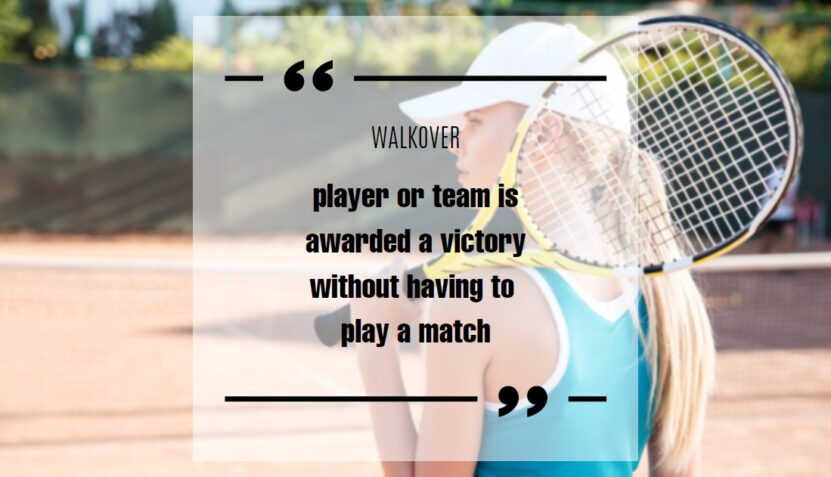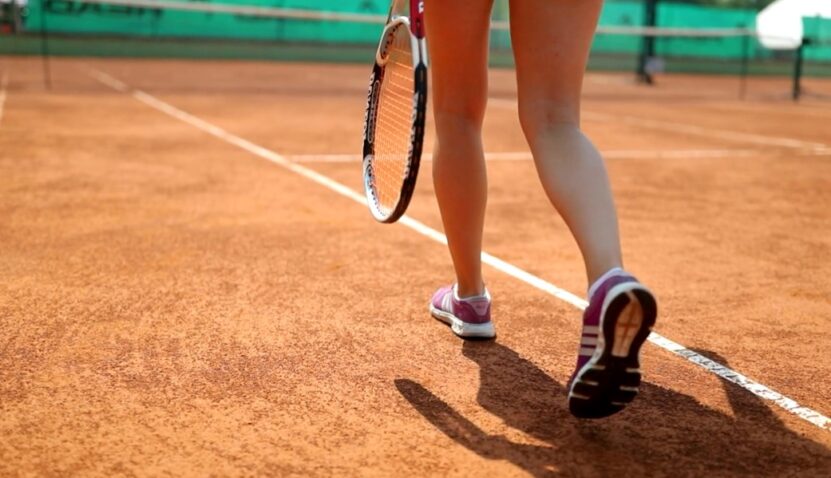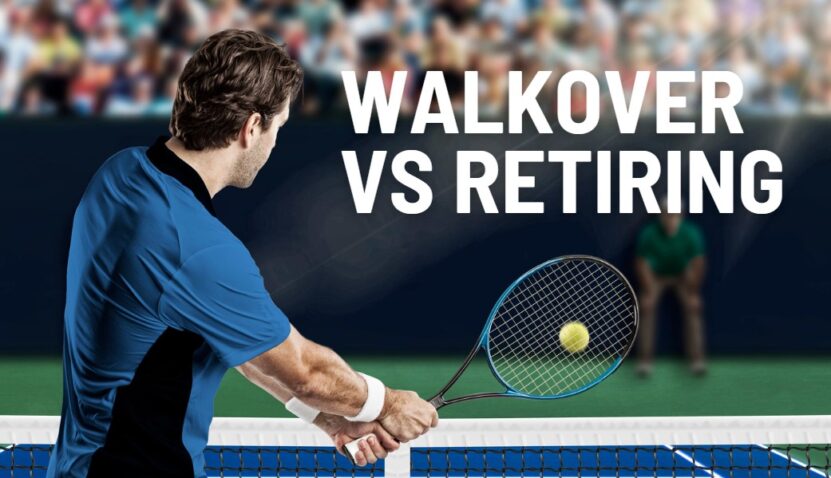Tennis is a popular sport played around the world, and it has its own set of rules and regulations that need to be followed. One such term that is commonly used in tennis is “walkover.” In this blog post, we will discuss what a walkover is in tennis and how it affects the game.
What Does This Rule Mean?
A walkover, also known as a “W/O,” is a term used in tennis to describe a situation where one player advances to the next round without having to play a match. This can occur for a variety of reasons, including injury, illness, or disqualification of the opposing player.
When a player receives a walkover, it means that they automatically win the match and advance to the next round of the tournament. They do not have to play a single point on the court to advance.

Reasons for Walkover in Tennis
There are several reasons why a player may receive a walkover in a tennis match. The most common reasons include:
- Injury: If a player is injured and unable to compete, they may have to withdraw from the tournament, which will result in a walkover for their opponent.
- Illness: If a player becomes ill and is unable to compete.
- Disqualification: If a player violates the rules of the tournament, they may be disqualified from the competition, resulting in a walkover for their opponent.
- No-show: If a player fails to show up for their scheduled match, they will be considered a no-show, and the end result is the same as in previous examples.
Impact of This Rule on the Tournament

Walkovers can have a significant impact on the tournament, both for the player who receives it and the tournament as a whole. For the player, it can be a mixed bag. On the one hand, they advance to the next round without having to play a match, which can save them energy and reduce the risk of injury. On the other hand, they may not have the opportunity to get into some valuable match practice, which could hurt them in later rounds.
For the tournament, walkovers can be both good and bad. On the one hand, they can help keep the schedule on track by eliminating the need for a match that is unlikely to be competitive. On the other hand, walkovers can be disappointing for fans who are looking forward to watching a particular match, and they can also affect the fairness of the tournament.
Fairness of the Rule in Tennis
One of the main concerns with walkovers in tennis is the fairness of the competition. If one player receives a walkover, they automatically advance to the next round without having to play a match. This can give them an advantage over other players who have had to play and win matches to advance.
To address this issue, many tournaments have rules in place that require players to play a minimum number of matches to be eligible for prize money or ranking points. Additionally, some tournaments have implemented “lucky loser” rules, which allow the highest-ranked losing player from the previous round to take the place of a player who has withdrawn or been disqualified.
Origin of this Rule

The origin of the term “walkover” in tennis can be traced back to the early days of the sport. It is believed that the term comes from horse racing, where a racehorse that won a race without any competition was said to have a “walkover.”
The term was then adopted in other sports, including tennis, to describe a situation where one player advances to the next round without playing a match. While the term has been used in tennis for many years, it is still a source of confusion and frustration for fans and players alike, as it can disrupt the flow of the tournament and deprive fans of exciting matches. Despite this, walkovers remain a part of the sport and are likely to continue to occur in the future.
Examples of Walkovers in WTA and ATP
In the WTA, one notable example of a walkover occurred at the 2021 Italian Open. In the quarterfinals, world No. 1 Ashleigh Barty was set to face American teenager Coco Gauff. However, Gauff was forced to withdraw from the match due to injury, giving Barty a walkover into the semifinals. While Barty no doubt appreciated the extra rest, it was likely disappointing for fans who were looking forward to watching two of the sport’s rising stars compete.
In the ATP, a recent example of a walkover occurred at the 2021 US Open. In the third round, world No. 3 Stefanos Tsitsipas was set to face Adrian Mannarino of France. However, Mannarino was forced to retire from the match due to injury after just two games, giving Tsitsipas a walkover into the fourth round. While Tsitsipas no doubt appreciated the extra rest, it was likely disappointing for Mannarino, who had fought hard to get to that point in the tournament.
Some of the key differences between Association of Tennis Players and Womens Tennis Association are the tournaments rules, prize winnings and other things like the duty felt ball that you would be surprised to find out.
The Difference Between Walkover and Retiring a Match

While both walkover and retiring are terms used in tennis to describe situations where a player is unable to finish a match, there are some key differences between the two.
A walkover occurs when a player advances to the next round of the tournament without having to play a single point. In this situation, the match is never played, and the winning player is awarded the victory by default. This can be advantageous for the players who receive it, as they get extra rest and do not have to expend energy in a match.
Retiring, on the other hand, occurs during a match when a player is unable to continue playing due to injury, illness, or other reasons. When a player retires, they forfeit the match to their opponent, who is awarded the victory.
Unlike a walkover, retiring occurs during the match and can have an impact on the outcome of it. If a player retires early in the match, it can be frustrating for both the opponent and the fans who are looking forward to watching a competitive match.
Another key difference between walkovers and retiring is how they are recorded in a player’s record. When a player receives a walkover, it is not counted as a win or a loss in their official record.
It is simply marked as an advancement to the next round of the tournament. However, when a player retires, the match is recorded as a loss in their official record, even if they were winning before the act. This can have an impact on a player’s ranking and can be very frustrating for players who are forced to retire due to injury or illness.
Frequently Asked Questions
1. How is the walkover different from retirement?
It occurs before the match and results in the player advancing to the next round without playing a single point, while a retirement occurs during the match and results in a forfeit to the opponent.
2. Does a player who receives it gets credit for a win?
No, it is not counted as a win or a loss in a player’s official record. It is simply recorded as an advancement to the next round of the tournament.
3. Can a player who receives a walkover still play in the tournament?
Yes, a player who receives it can still play in the tournament and continue to advance to later rounds.
4. How common is it in tennis?
They are relatively rare in professional tennis, but they can occur for a variety of reasons. They are more common in lower-level tournaments, where players may be more prone to injury or illness.
5. Do walkovers have an impact on a player’s ranking?
No, they are not counted as wins or losses in a player’s official record, so they do not have an impact on a player’s ranking.
6. Can walkovers be prevented?
While this cannot always be prevented, players can take steps to reduce their risk of injury or illness, such as getting proper rest, staying hydrated, and warming up properly before matches.
7. How does this rule impact the tournament?
Walkovers can disrupt the flow of the tournament and deprive fans of exciting matches, but they can also provide an advantage for players who receive them, as they get extra rest and do not have to expend energy in a match.
Final Words
In conclusion, a walkover in tennis is a necessary rule that was a point of frustration in some rare situations. It is safe to say that it is much more common in lower tiers of white sports competitions, and it is very rare in matches between the top 100 players.
While walkovers can have a significant impact on the tournament, they can also raise concerns about fairness. To address these concerns, many tournaments have rules in place to ensure that players play a minimum number of matches and that the highest-ranked losing player has an opportunity to continue in the tournament.
If you are a tennis enthusiast and want to improve your game, check out our article about the best exercises you can do in your home and some useful tips on improving your fitness.

